Gemstones have long fascinated humanity, captivating with their mesmerizing beauty and enduring allure. Among the plethora of gemstones available, diamonds, rubies, and emeralds stand out as the prestigious members of the “big three.” In this article, we delve into the complexities of gemstone valuation, focusing particularly on the cost disparity between diamonds, rubies, and emeralds.
Comparison of Rarity and Durability:
Diamonds, rubies, and emeralds, collectively known as the “big three” gemstones, possess distinct characteristics that contribute to their allure and value. Rarity and durability are paramount among these attributes.
Diamonds, composed of pure carbon and formed deep within the Earth’s mantle under extreme pressure and heat, are renowned for their exceptional hardness, scoring a perfect 10 on the Mohs scale. Their rarity, coupled with enduring demand, renders diamonds highly valuable.
Rubies, on the other hand, owe their vibrant red hue to the presence of chromium during formation. While not as hard as diamonds, rubies still boast a commendable durability, scoring a 9 on the Mohs scale. Their scarcity and intense coloration, particularly exemplified by the coveted “pigeon’s blood” hue, contribute significantly to their value.
Emeralds, prized for their lush green color, derive their hue from trace amounts of chromium, vanadium, or iron. While emeralds exhibit a lower hardness rating of 7.5 to 8 on the Mohs scale, their rarity, especially the fine specimens from Colombia, and distinct coloration make them highly desirable in the gemstone market.
Formation and Color:
The formation process of gemstones significantly influences their appearance and value. Rubies and emeralds, in particular, owe their coloration to specific mineral compositions and geological conditions.
Rubies, distinguished by their brilliant red hue, owe their color to the presence of chromium within the crystal lattice during formation. This vibrant red hue, often likened to the color of fresh blood or pigeon’s blood, is highly sought after among collectors and enthusiasts.
Emeralds, characterized by their captivating green color, acquire their hue from trace amounts of chromium, vanadium, or iron. The intensity and shade of green vary depending on the specific mineral composition and geological conditions during formation. The most prized emeralds exhibit a vivid, saturated green color reminiscent of lush foliage.
Geographical Sources:
The geographical origin of gemstones plays a pivotal role in determining their quality, value, and market demand. Traditional sources for rubies include Myanmar, Thailand, Pakistan, and Sri Lanka, each renowned for producing exquisite specimens with varying characteristics.
Myanmar, historically known as Burma, has long been celebrated for its exceptional rubies, particularly those from the Mogok region. These rubies are revered for their intense color saturation and exceptional clarity, fetching premium prices in the global market.
In contrast, emeralds, particularly those of Colombian origin, dominate the global market. Colombia’s rich geological landscape, characterized by the presence of emerald-bearing deposits, yields some of the finest emeralds renowned for their exceptional color, clarity, and brilliance. Colombian emeralds command premium prices due to their unparalleled quality and rarity.
Assessment Factors:
Gemstone valuation encompasses various factors, commonly referred to as the Four C’s: cut, color, clarity, and carat weight. Each of these factors influences the overall value and desirability of a gemstone.
The cut of a gemstone, meticulously executed by skilled lapidaries, enhances its brilliance, fire, and overall aesthetic appeal. Rubies are often fashioned into classic cuts such as cushion or oval, accentuating their inherent beauty and color saturation. Emeralds, with their unique crystal structure, are typically fashioned into emerald cuts, maximizing their color and clarity while minimizing inclusions.
Color is a critical determinant of a gemstone’s value, with vivid, saturated hues commanding premium prices. Rubies prized for their intense red coloration, particularly those exhibiting the coveted “pigeon’s blood” hue, are highly sought after by collectors and connoisseurs. Similarly, emeralds with a rich, vibrant green color fetch premium prices due to their rarity and visual appeal.
Clarity refers to the presence or absence of internal inclusions and external blemishes within a gemstone. While inclusions are common in both rubies and emeralds, they are often viewed as natural characteristics that add to the gemstone’s unique allure and charm. However, gemstones with exceptional clarity and minimal inclusions command higher prices in the market.
Carat weight, representing the physical size and mass of a gemstone, also influences its value. Larger gemstones, regardless of their type, generally command higher prices due to their rarity and visual impact. However, the interplay of the other three C’s—cut, color, and clarity—significantly influences the overall value proposition of a gemstone.
In conclusion, the relative cost of diamonds, rubies, and emeralds is influenced by a myriad of factors including rarity, durability, color, geographical origin, and assessment criteria such as the Four C’s. While diamonds remain the most universally coveted gemstone, rubies and emeralds, with their distinctive characteristics and rich histories, continue to captivate enthusiasts and collectors alike, commanding their rightful place among the world’s most precious treasures.

